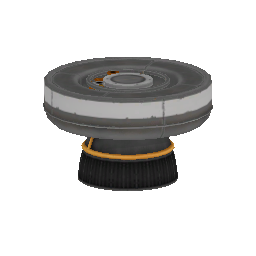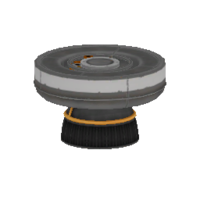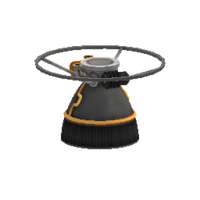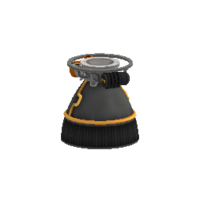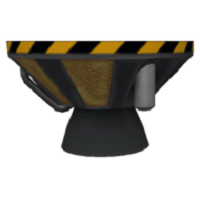Difference between revisions of "LV-909 "Terrier" Liquid Fuel Engine"
m (Move image) |
AlpacaMall (talk | contribs) m (removed duplicate sentence + short summary of main strength in intro) |
||
| (10 intermediate revisions by 3 users not shown) | |||
| Line 1: | Line 1: | ||
{{:LV-909 "Terrier" Liquid Fuel Engine/Box}} | {{:LV-909 "Terrier" Liquid Fuel Engine/Box}} | ||
| − | The '''LV-909 "Terrier" Liquid Fuel Engine''' is a [[liquid fuel engine]]. | + | The '''LV-909 "Terrier" Liquid Fuel Engine''' is a [[Radial size|1.25m]] [[liquid fuel engine]], with a high vacuum [[specific impulse]] and fuel efficiency. |
| + | |||
| + | == Product description == | ||
| + | {{Quote | ||
| + | |The 909 model was initially received with some skepticism by spacecraft engineers, as it defied the long-standing convention that "More Power!" is always better. Despite this, the 909 series has found its place in the spacecraft construction world, being particularly useful as a final stage and landing engine. | ||
| + | |manufacturer=JKJSP}} | ||
== Usage == | == Usage == | ||
| − | The | + | The Terrier is the first true vacuum engine unlocked in the [[tech tree]]. While its [[specific impulse]] (I<sub>sp</sub>) at sea level (85 s) is unusably low, its vacuum I<sub>sp</sub> (345 s) is significantly higher than almost any engine of its size (apart from the [[T-1 Toroidal Aerospike "Dart" Liquid Fuel Engine]]). In addition, it has the lowest mass of any [[Radial size|1.25m]] engine, lower than that of the [[LV-T30 "Reliant" Liquid Fuel Engine]] or [[LV-T45 "Swivel" Liquid Fuel Engine]]. This makes it the most efficient engine for many medium-size crafts; using a Terrier engine will help maximize available delta-V. |
| − | + | The Terrier is short enough that [[LT-1 Landing Strut]]s can extend past it. Combined with the Terrier's thrust vectoring, this makes it a good choice for lander engines. However, the Terrier's thrust is low; for large ships, it may not provide enough thrust in high-gravity environments. | |
| − | The thrust vectoring on this engine tends to be less useful than on the | + | The thrust vectoring on this engine tends to be less useful than on the Swivel, due to the Terrier's reduced gimbal range and the fact that it is often used on lighter rockets, which can be turned easily by the [[SAS]] torque provided by the command pod or probe body. |
| − | Be aware that unlike the | + | Be aware that unlike the Swivel and Reliant, the Terrier does not have an alternator, meaning it cannot produce [[electric charge]]. Another source of power (even if just [[battery|batteries]]) is therefore strongly recommended for any spacecraft that uses it. |
| − | |||
| − | |||
| − | |||
| − | |||
| − | |||
| − | |||
| − | |||
== Variants == | == Variants == | ||
| − | As of {{version|1.6}} this engine has three | + | As of {{version|1.6}} this engine has three models that can be switched in the editor. |
{{multiple image | {{multiple image | ||
| Line 36: | Line 34: | ||
[[File:LV909.png|thumb|right|Pre-0.18 appearance]] | [[File:LV909.png|thumb|right|Pre-0.18 appearance]] | ||
| + | |||
| + | [[File:LV-909_v1.5.png|thumb|right|Pre-1.6 appearance]] | ||
== Changes == | == Changes == | ||
Latest revision as of 06:45, 21 September 2021
| LV-909 "Terrier" Liquid Fuel Engine | ||
| Liquid fuel engine by Jebediah Kerman's Junkyard and Spacecraft Parts Co | ||
| Radial size | Small | |
| Cost | (total) | 390.00 |
| Mass | (total) | 0.500 t |
| Drag | 0.2 | |
| Max. Temp. | 2000 K | |
| Impact Tolerance | 7 m/s | |
| Research | | |
| Unlock cost | 1 600 | |
| Since version | 0.14 | |
| Part configuration | liquidEngineLV-909_v2.cfg | |
| Maximum thrust | (1 atm) | 14.78 kN |
| (vacuum) | 60.00 kN | |
| Isp | (1 atm) | 85 s |
| (vacuum) | 345 s | |
| Fuel consumption | 3.55 | |
| Thrust vectoring | 4 ° | |
| Testing Environments | ||
| On the surface | Yes | |
| In the ocean | Yes | |
| On the launchpad | Yes | |
| In the atmosphere | Yes | |
| Sub-orbital | Yes | |
| In an orbit | Yes | |
| On an escape | Yes | |
| Docked | No | |
| Test by staging | Yes | |
| Manually testable | Yes | |
| Packed volume | 1300 l | |
The LV-909 "Terrier" Liquid Fuel Engine is a 1.25m liquid fuel engine, with a high vacuum specific impulse and fuel efficiency.
Contents
[hide]Product description
| “ | The 909 model was initially received with some skepticism by spacecraft engineers, as it defied the long-standing convention that "More Power!" is always better. Despite this, the 909 series has found its place in the spacecraft construction world, being particularly useful as a final stage and landing engine. — Jebediah Kerman's Junkyard and Spacecraft Parts Co |
” |
Usage
The Terrier is the first true vacuum engine unlocked in the tech tree. While its specific impulse (Isp) at sea level (85 s) is unusably low, its vacuum Isp (345 s) is significantly higher than almost any engine of its size (apart from the T-1 Toroidal Aerospike "Dart" Liquid Fuel Engine). In addition, it has the lowest mass of any 1.25m engine, lower than that of the LV-T30 "Reliant" Liquid Fuel Engine or LV-T45 "Swivel" Liquid Fuel Engine. This makes it the most efficient engine for many medium-size crafts; using a Terrier engine will help maximize available delta-V.
The Terrier is short enough that LT-1 Landing Struts can extend past it. Combined with the Terrier's thrust vectoring, this makes it a good choice for lander engines. However, the Terrier's thrust is low; for large ships, it may not provide enough thrust in high-gravity environments.
The thrust vectoring on this engine tends to be less useful than on the Swivel, due to the Terrier's reduced gimbal range and the fact that it is often used on lighter rockets, which can be turned easily by the SAS torque provided by the command pod or probe body.
Be aware that unlike the Swivel and Reliant, the Terrier does not have an alternator, meaning it cannot produce electric charge. Another source of power (even if just batteries) is therefore strongly recommended for any spacecraft that uses it.
Variants
As of version 1.6 this engine has three models that can be switched in the editor.
Changes
- New model and texture
- Added 3 variants
- New, higher quality model applied.
- Max thrust increased from 20 to 50; vacuum ISP reduced from 400 to 390.
- Initial Release
| ||||||||||||||||||||||||||||||||||||||||||||||||||||||||||||||||||||||||||||||||||
